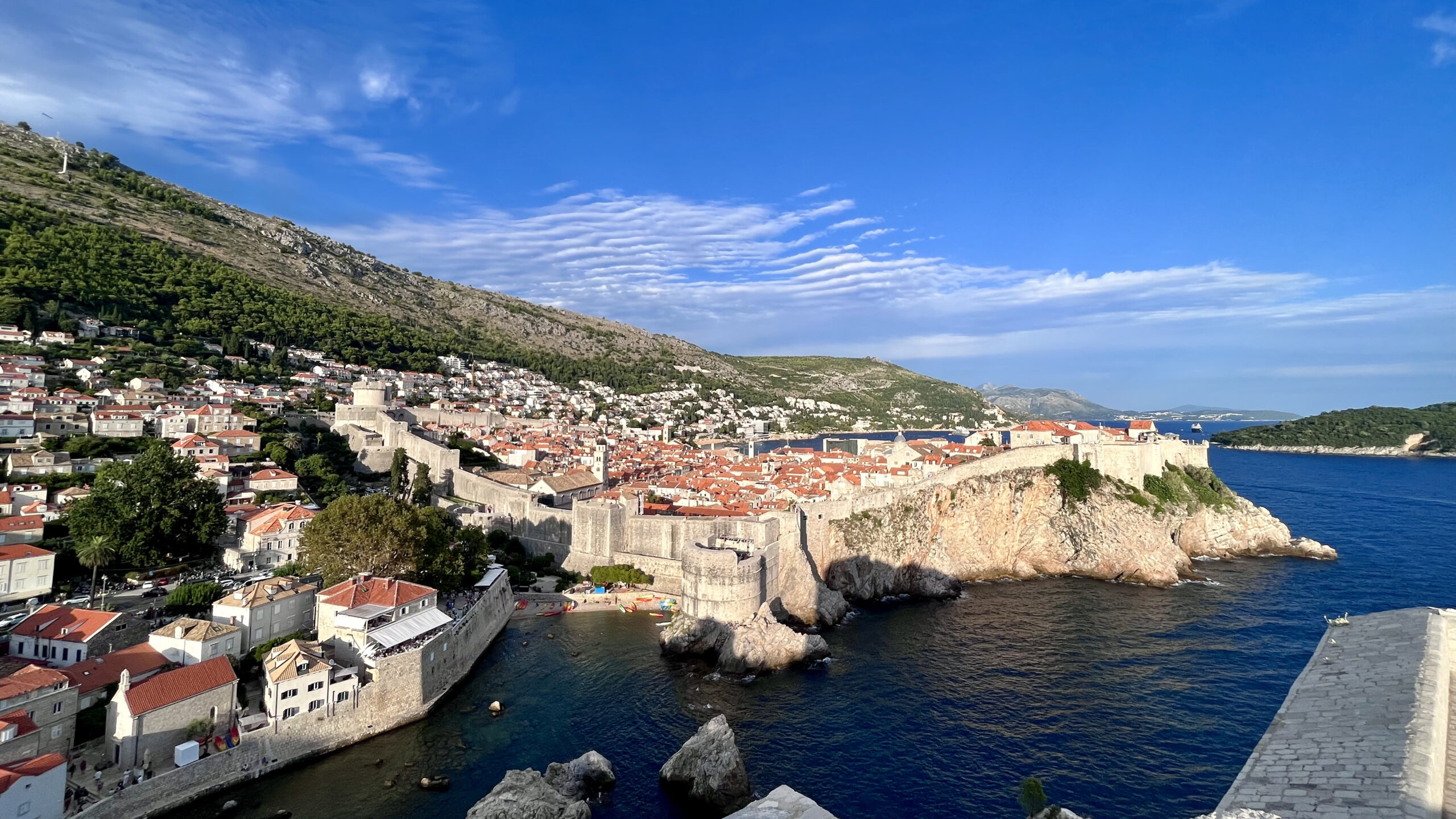
Balkans Revealed: Discovering Southeastern Europe’s culinary treasures and unexpected delights
Story and photography by Shilo Urban
Croatia
Am I still asleep on the plane and dreaming? This place can’t be real. I’d just arrived in the walled city of Dubrovnik on the coast of Croatia, a gleaming castle town drawn right out of a medieval storybook. Towering battlements encircle a labyrinth of limestone streets that shine like marble against the azure Adriatic Sea. The historic city is abuzz in the brilliant summer sun. Bells resound from grand baroque churches and beachgoers fill their bottles with spring water from centuries-old fountains. Couples clink wine glasses at tiny tables. Staircases snake up narrow lanes and secret passageways sneak through the walls to cocktail bars that cling to the cliffs outside. Every third person is eating gelato, and soon, I am, too: a cone of mascarpone pistachio with a swirl of caramelized figs.
It’s the first taste of my foodie extravaganza in the Balkan Peninsula, a lesser-traveled corner of Europe that stretches from Italy to Greece and eastward to the Black Sea. Olive groves and vineyards share the mountainous landscape with hilltop fortresses and quiet villages, shimmering lakes and striking modern cities. The land’s diverse cultural influences show up deliciously on the Balkan table, including Ottoman, Arab, Persian, Mediterranean and Central European flavors. Here on the Dalmatian Coast, dining is outdoors — and just-caught seafood is always on the menu. And the pasta game is on point, thanks to the Venetians that dominated this spectacular stretch of shoreline for hundreds of years.
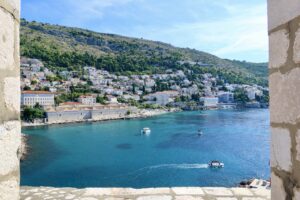 The feast begins. I dive into traditional Croatian cuisine at the waterfront restaurant Arsenal, where the sea breeze complements my briny crni rižot (black squid risotto). I order plump grilled mussels at Dubravka 1836, sipping a lavender-hibiscus cocktail from my perch above the west harbor (that’s Blackwater Bay to you “Game of Thrones” fans, for Dubrovnik is none other than King’s Landing). At Kopun Restaurant, the chefs are bringing back a forgotten Croatian dish: capon roosters. The tender white meat sings in my technicolor salad, but I’m distracted by the setting, an elevated courtyard in the shadow of an ornate Jesuit church.
The feast begins. I dive into traditional Croatian cuisine at the waterfront restaurant Arsenal, where the sea breeze complements my briny crni rižot (black squid risotto). I order plump grilled mussels at Dubravka 1836, sipping a lavender-hibiscus cocktail from my perch above the west harbor (that’s Blackwater Bay to you “Game of Thrones” fans, for Dubrovnik is none other than King’s Landing). At Kopun Restaurant, the chefs are bringing back a forgotten Croatian dish: capon roosters. The tender white meat sings in my technicolor salad, but I’m distracted by the setting, an elevated courtyard in the shadow of an ornate Jesuit church.
Yet my favorite restaurant in Dubrovnik has no view at all. Hidden down a skinny side street, Carmen is a pint-sized Italian trattoria with a handful of tables. It was recommended by Nikolina, a born-and-bred local who runs my guest house, the 17th-century Villa Sigurata. After an amuse-bouche of raw oysters, I fall head over heels for the shrimp and truffle casarecce, a cream-ridden pasta paradise with so much flavor it defies the laws of physics. I slowly savor every last bite while attempting to ignore the line of hungry faces waiting for a table.
By my last night in Dubrovnik, I consider myself a gelato connoisseur. I’ve tried lemon cake gelato, blackberry goat cheese and peanut butter with rosehip jam. I’ve learned that the finest gelato is never piled high in mounds but lies flat in the pan, like you’ll find at Gianni, Peppino’s and Mostro. I indulge in a final scoop of decadent dark chocolate and amble around aimlessly, trying to soak up a little bit more of Dubrovnik’s magic. I’m still not entirely convinced that the city is real.
Montenegro
I leave Croatia with a skip in my step and a gelato stain on my shirt, buoyed by the beauty of the coastal drive to Kotor in Montenegro. I’ve joined up with five other travelers on a tour with Intrepid, an Australian company whose independent, close-to-the-ground excursions use local guides, hotels and drivers. Our group hails from four different continents, and our Serbian guide Dušan is a 29-year-old folk dancing delight.
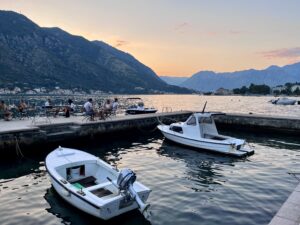 Rumpled green mountains rise on our left as we travel around the brooding, sapphire Bay of Kotor to its namesake city. Like Dubrovnik, Kotor is carless and ringed by stout stone walls. But it’s much smaller, a cluster of gem-box churches and cobblestone squares strewn with cafes. We sup on flame-kissed tuna at the bayfront Caffe del Mare; it’s been cooked on the wood-burning grill out front. Pleasure boats bob in the water and a golden glow seeps across the sky as the sun sinks low. We decamp to a standing-room-only jazz show that shakes the stars above with squealing funk. But by morning, all is hushed … except for a snow-white billy goat bleating high on the cliffs above. A baker hums softly to herself and a gang of kittens wrestle in the empty lanes. I’m in Kotor for only one night, but I make up for the brief stay with four scoops of gelato while I’m there (the batter-thick almond and hazelnut gelato at Marshall’s takes the cake).
Rumpled green mountains rise on our left as we travel around the brooding, sapphire Bay of Kotor to its namesake city. Like Dubrovnik, Kotor is carless and ringed by stout stone walls. But it’s much smaller, a cluster of gem-box churches and cobblestone squares strewn with cafes. We sup on flame-kissed tuna at the bayfront Caffe del Mare; it’s been cooked on the wood-burning grill out front. Pleasure boats bob in the water and a golden glow seeps across the sky as the sun sinks low. We decamp to a standing-room-only jazz show that shakes the stars above with squealing funk. But by morning, all is hushed … except for a snow-white billy goat bleating high on the cliffs above. A baker hums softly to herself and a gang of kittens wrestle in the empty lanes. I’m in Kotor for only one night, but I make up for the brief stay with four scoops of gelato while I’m there (the batter-thick almond and hazelnut gelato at Marshall’s takes the cake).
Albania
Please don’t go hiking in flip-flops. A bizarre billboard greets us just past the Albanian border crossing, where they don’t check our passports or even look to see if we’re carrying them. I’m not sure what to expect from Albania. The country was closed to travelers for much of the 20th century, suffering under a hardcore communist regime (Albania’s dictator broke ties with Russia and China during the Cold War because they weren’t Communist enough). But that was decades ago, and today, Albania is a pleasant surprise. Crumbling castles vie with dramatic peaks and postcard-perfect beaches for the traveler’s attention, and there’s just enough oddball quirk to make you feel like an adventurer. Albanians are incredibly friendly, and they seem to love Americans — souvenir shops sell USA flags and one village even has a shirt-sleeved statue of George W. Bush.
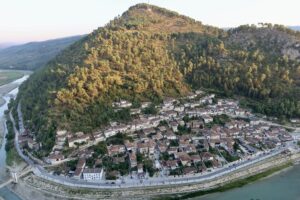 But we’re heading to the big city, the sparkling capital of Tirana. Youthful energy whips around the live-wire metropolis and 80s music tumbles from coffee shops. Daring brutalist and modern architecture add personality with wild shapes and colors. We’re less than 20 miles from the sea, but the culinary mood has shifted toward triangular byrek pastries, cheese-stuffed peppers and meaty stews. Cornfields surround Tirana and cornbread figures high on many menus; the white-tablecloth restaurant Era serves crunchy squares of it drowning in a yogurt sauce with pesto.
But we’re heading to the big city, the sparkling capital of Tirana. Youthful energy whips around the live-wire metropolis and 80s music tumbles from coffee shops. Daring brutalist and modern architecture add personality with wild shapes and colors. We’re less than 20 miles from the sea, but the culinary mood has shifted toward triangular byrek pastries, cheese-stuffed peppers and meaty stews. Cornfields surround Tirana and cornbread figures high on many menus; the white-tablecloth restaurant Era serves crunchy squares of it drowning in a yogurt sauce with pesto.
More Albanian treats await in the riverside hamlet of Berat, a white-washed jumble of flat, Ottoman-style homes that climb up the hillside. A fortress looms above. We start our family-style feast at WilDor with a board-load of leek pie and pickled green tomatoes. Fërgesë comes next, a feta and red pepper casserole that’s bubbling hot. We have chunky Mediterranean salad and croquettes of farmer’s cheese, spicy kofta meatballs and tangy green olives. Wine and bread? Of course. I can only eat a few bites of the succulent grilled lamb and veal that arrive next … but there’s always room for something sweet. Tres leches cake is Albania’s trendiest dessert and tempting. But I choose the forest fruits gelato with kataifi, a pastry made with thin, delicate strands of phyllo dough. We finish with rakija, the strong, clear brandy that’s ubiquitous in the Balkans.
North Macedonia
We have rakija again the next day as we cruise glassy Lake Ohrid, located just over the border in North Macedonia. Our boat’s captain shares his fiery homemade spirit from a water bottle, then pours us several rounds of potent Turkish-style coffee. We sip both from petite plastic cups and jump into the lake. The two drinks balance each other out (right?), and I find myself in a fine state for exploring the fun-loving resort town of Ohrid. I wander winding cobblestone streets in the old Ottoman quarter and end up at the Church of Saint John, an incense-filled Byzantine chapel of brick and stone.
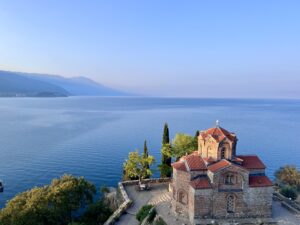 As the afternoon heats up, we head to Monastery Winery to relax in the woodsy mountain hideaway, which has a vast open-air tasting room and a trio of happy-faced dogs. The Balkans’ bountiful viniculture produces a wide range of wines, from the deep red vranec to the dry white traminec (my favorite). You can also try orange wine, a grippy and funk-forward pour (not my favorite). At Monastery we taste whites, rosés, reds and rakijas — and our charcuterie board is heavy with the Balkans’ signature cured sausage and ajvar, a smoky-sweet red pepper relish.
As the afternoon heats up, we head to Monastery Winery to relax in the woodsy mountain hideaway, which has a vast open-air tasting room and a trio of happy-faced dogs. The Balkans’ bountiful viniculture produces a wide range of wines, from the deep red vranec to the dry white traminec (my favorite). You can also try orange wine, a grippy and funk-forward pour (not my favorite). At Monastery we taste whites, rosés, reds and rakijas — and our charcuterie board is heavy with the Balkans’ signature cured sausage and ajvar, a smoky-sweet red pepper relish.
I skip dinner and sleep, a good idea because I need extra energy to tackle our next destination, over-the-top Skopje. Macedonia’s flashy capital radiates bravado with grandiose fountains and super-sized neoclassical buildings. Hundreds of elaborate statues adorn the downtown area; warriors and lions proliferate. I fuel up at Destan on ćevapi, charcoal-grilled rolls of minced beef. An order comes with ten ćevapi plus chopped white onion, a pale green pepper and puffy bread. It’s nothing fancy — but it’s absolutely delicious. The juicy, well-seasoned sausages balance perfectly with the simple sides. The Balkans love their grilled meats, and Destan serves the tastiest around.
Greece
Several fat peacocks are napping in the shade at the Greek border crossing, unperturbed by the thunk, thunk, thunk of the customs agent stamping our passports. We rumble along to Kastoria. Like Ohrid, Kastoria is a lake town — but that’s where the similarities cease. Ohrid’s lively atmosphere is replaced by Kastoria’s serene spirit. The chanting of monks wafts across the forested peninsula, their enigmatic incantations emerging from a 900-year-old monastery overlooking the water.
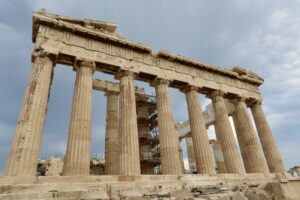 Nearby at the lakefront restaurant Grammofono I tuck into a Cretan dakos salad, a Greek-style salad that adds hard, crusty barley rusks. But the tomato steals the show, not just here but all over the Balkans, where the ruby-red gems grow abundantly. We’re introduced to the charming Greek tradition of complimentary dessert after your meal: a piece of baklava, a shot of ouzo or a bite of the citrusy, syrupy cake known as orange pie.
Nearby at the lakefront restaurant Grammofono I tuck into a Cretan dakos salad, a Greek-style salad that adds hard, crusty barley rusks. But the tomato steals the show, not just here but all over the Balkans, where the ruby-red gems grow abundantly. We’re introduced to the charming Greek tradition of complimentary dessert after your meal: a piece of baklava, a shot of ouzo or a bite of the citrusy, syrupy cake known as orange pie.
Soon it’s off to Mount Olympus, home of Zeus and the Greek gods. After a steep hike to a well-worth-it waterfall, we unwind in Litochoro. Nestled beneath the massive mountain, the village is a popular jumping-off point for outdoor pursuits. Taverns cluster around the clear stream that gurgles through town, and I cool off with a glass or two of white wine as tots splish-splash in the creek. Now energized to find dinner, we slip into a little café on the square called Pantheon. I try the grilled talagani, a cheese similar to halloumi but softer and richer. Served with apple chutney, the salty-sweet snack checks all the boxes. As evening falls, a kiddie carnival pops up in the city park and a local production of “Mamma Mia!” kicks off around the corner. I stop by the yuppie bakery Ephéssou for a nightcap of vanilla gelato mixed with pistachio kataifi, the same delicate pastry I had back in Berat. Textured and velvety, it’s the best gelato of my trip.
But the high notes aren’t over just yet. Our train rumbles south toward Athens in the morning, with Mount Olympus on the right and the turquoise Aegean Sea on the left. By mid-afternoon, I’m raising a glass of crisp aspro votsalo wine to the most important ancient site in the Western world: the Acropolis. It’s the crown jewel of my odyssey through the Balkans, and I have a panoramic view of the Parthenon from my table at the Acropolis Museum café. Gazing upward in awe just like travelers have for 2,500 years, I know that my journey’s greatest treasure isn’t made of marble or mountains or even gelato — it’s the soul-lifting experience that I will carry in my heart forever.
